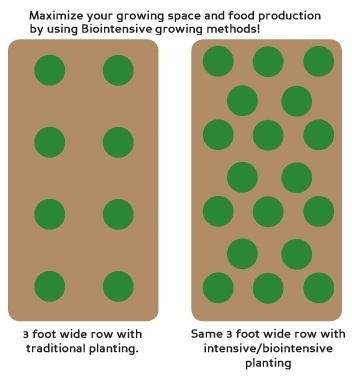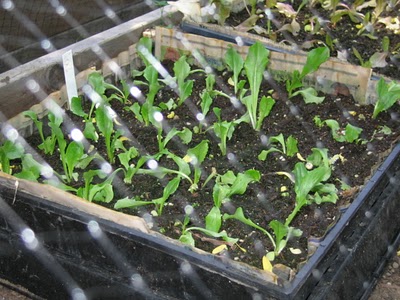Planting Garden Beds
Planting garden beds using the Biointensive method maximizes space. Unlike planting vegetables or seeds in evenly spaced rows, with the Biointensive method, you evenly spaced them from one another in a diagonal offset. This type of spacing allows plants in flats or beds to touch one another at the transplanting or maturity stage. When evenly spaced this way, a living-mulch is created, which restricts weed growth, retains soil moisture, and creates a microclimate under the leaves.
How Much Seed is Required when Planting Garden Beds
Not all the seeds you plant will germinate, so you will have to plant more seed than you require. In each Organic Gardening Fact Sheet for each vegetable in the Vegetables section, you will see the "Minimum legal germination rate" for each vegetable listing. This is the legal germination percentage rate set by the government.
To calculate how much seed you will need to plant:
A = Required number of seeds or plants
B = Legal germination rate
C= Amount of seed to plant
A ÷ B = C
Example:
90 corn plants are required
Legal germination rate for corn is 75%
90 ÷ .75 = 120 seeds to plant

Planting Garden Beds with Transplants
Starting with Flats
I recommend starting most of your vegetables in flats, except for some root crops, which are either broadcast or direct-seeded into your garden beds. Starting your vegetables in flats helps maximize the growing season. With flats, you can start growing your vegetables earlier in the season and it makes double cropping easier by having transplants ready to plant in the garden bed when the existing crop is finished.
[See crop rotation to make sure you’re following the vegetable nutrient relationship correctly.]
In the Organic Gardening Fact Sheet for each vegetable, the spacing for both flat and garden bed is listed. For most of your vegetables, you will transplant the seedlings into a second deeper flat with twice the spacing distance as the first. As soon as the leaves touch, they are transplanted into your garden bed. The vegetables that require only one flat cycle are your root crops and grasses, such as corn and other grains. The grasses are transplanted into the garden bed as soon as they reach 2 in (51 mm) or develop two full leaves.Transplanting to the Garden Bed
Once the seedlings are ready to plant into your garden bed, carefully dig out the seedling from the flat, dig a hole in your garden bed, and plant it. I often use a watering can and pour some water into the hole before I plant it to prevent transplant shock. Don’t pack the soil around the seedling too much when planting garden beds. With practice, you'll get the hang of it. I did! Remember to use evenly spaced diagonal offsets between your plants.

Direct Seeding Your Garden
For some of your vegetables (see root crops) it’s easier to plant the seed directly into the garden bed. Remember to plant your seeds with evenly spaced diagonal offsets. As a reminder, The "In garden spacing" is listed in the Organic Gardening Fact Sheet for each vegetable in the Vegetables section.

Broadcasting Seeds
Broadcasting seed into your flats takes practice, but after
awhile you'll learn to broadcast the seeds evenly.
For broadcasting into garden beds, I find the following method useful:
- Pour your seeds into a 5-gallon (23 liter) bucket.
- Mix in sifted compost, soil, or sand. Make sure you mix it well. I prefer to use compost, as it will be darker than the underlying soil.
- Broadcast the mixture over the area you're planting. The seed mix will be a different color than the underlying soil, making it easy to see how evenly spread it is.
- Water well and never let the area dry out.
Home › Vegetable Garden Beds › Planting Garden Beds
Return to the Top of Planting Garden Beds



Comments
Have your say about what you just read! Leave me a comment in the box below.